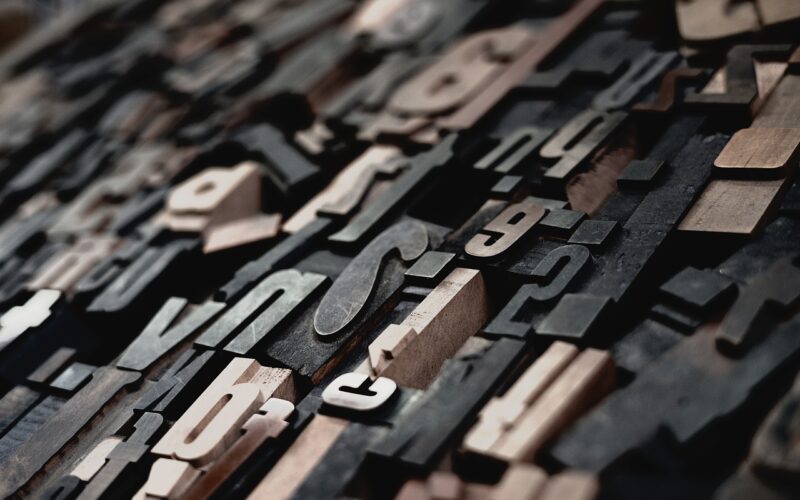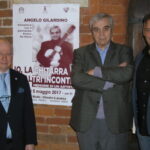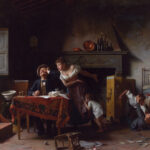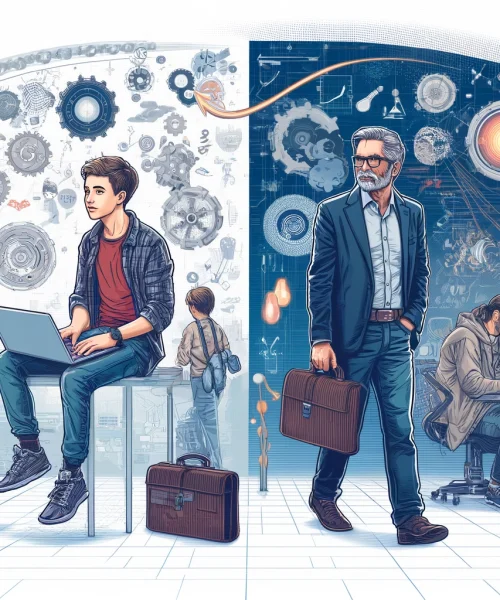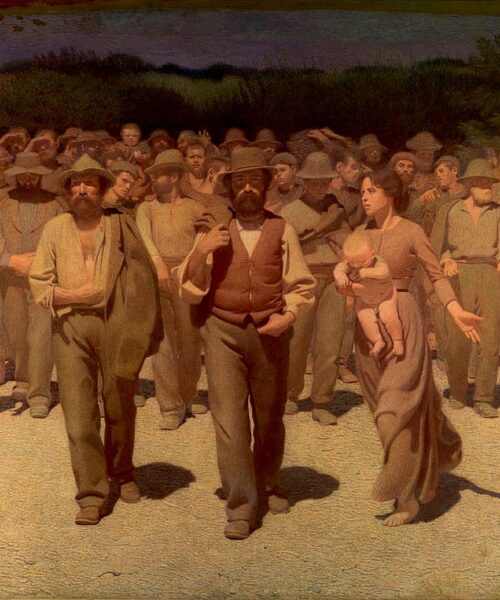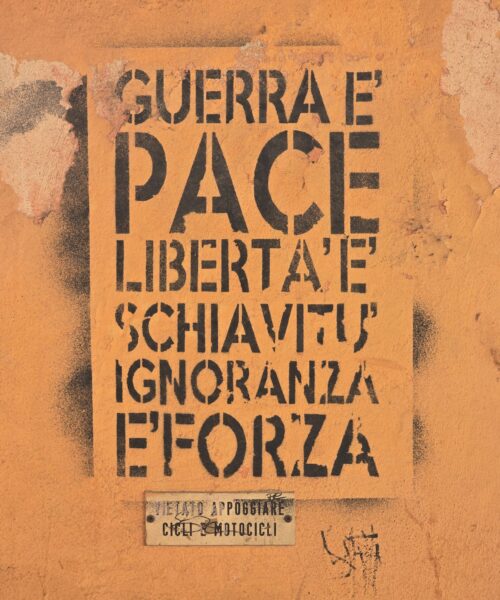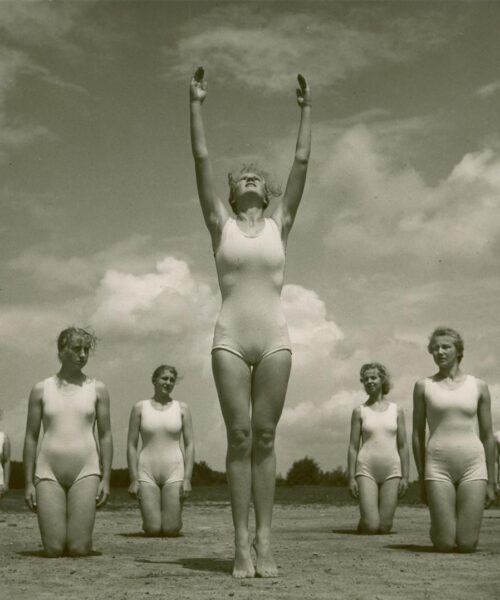In a world now immersed in the digital age, where Artificial Intelligence promises to redefine the boundaries of the possible, it’s not hard to see a parallel with another historical moment of great disorientation and fervor: the advent of movable type printing in the 15th century. When Johannes Gutenberg unveiled his revolutionary invention, the reaction was anything but unanimous. For some, printing represented the promise of a new Renaissance for humanity, while for others, it evoked fears and concerns that touched various layers of society, from religion to politics, from culture to the social fabric.
Just like today, with the rise of Artificial Intelligence fueling heated debates on information control, privacy, and ethics, Gutenberg’s technological innovations brought with them a flurry of questions and uncertainties. A primary concern was indeed the control of information.
Information Control
In the damp crypts of monasteries and the sacred rooms of cathedrals, books rested as invaluable treasures, protected by keys and seals. They were manuscripts meticulously copied by consecrated hands, often decorated with miniatures and gold ink. Each page was a work of art, and each book a vehicle for divine knowledge that only a few chosen ones had the privilege to consult.
But then came the press, that ingenious machine that promised to multiply words like never before. Fear grew like a shadow in the minds of the religious and intellectual elite. How could they maintain their role as guardians of knowledge if every citizen could hold a Bible in hand, read classical texts, or even political and philosophical writings?
The idea that information control could slip from the hands of those who had built entire institutions on the monopoly of knowledge was staggering. Bishops and abbots convened in secret councils, while philosophers and academics debated fervently in university halls. The press was not just a machine; it was a catalyst for change, an earthquake that threatened to upset the established order.
For many, the dilution of power was a daunting prospect. If knowledge had been concentrated like precious nectar, now it risked becoming an uncontrollable river. Not only sacred texts but also scientific treatises, poems, historical chronicles, all could be copied and spread with astonishing ease. And who could guarantee that such texts would be interpreted correctly? That they wouldn’t generate heresies, revolutions, or simply confusion?
It was thought that the value of information also lay in its rarity, in the fact that not everyone could access it. Printing seemed to promise a world where knowledge would be democratic, but for many, this was not a good thing. It was a threat to social order, to hierarchy, to the delicate balance of power that had governed societies for centuries.
So, while Gutenberg’s presses and those of his successors hummed, churning out sheets of paper that would change the world, in the silent rooms of sacred buildings and academies, the elite sought ways to control the uncontrollable. Licenses, censorship, lists of forbidden books: all strategies put in place to try to tame the revolutionary power of the press.
But history, as always, followed its course, and the shadow of fear dissolved in the light of dawn of a new era. However, those concerns never completely disappeared, and they still resonate in every debate about information control in the digital age.
Heresy and Sedition
In the crypts of sacred libraries and the secret rooms of government buildings, a growing shadow stretched over the minds of the custodians of order. The press, that technological Pandora’s box, had opened the doors not only to knowledge but also to heresy and sedition.
For the Church, the fear was visceral. Manuscripts that once required months, if not years, to transcribe could now be replicated in hundreds of copies in just a few days. This meant that not only the Holy Scriptures but also texts of a much more dangerous nature could find a wider audience. The thought that heretical treatises or heterodox interpretations of the Scriptures could spread like an unstoppable fire was a nightmare for those who saw the Church as the only true bulwark against spiritual darkness.
Similarly, in the corridors of political power, rulers and advisors looked around with unease. If before the written word was a means of communication limited to the nobility and the educated elite, now even the common people could have access to revolutionary ideas. Documents demanding more freedom, pamphlets criticizing tyranny, texts inciting rebellion: all this could now be spread on a large scale, with a potentially devastating impact on political stability.
And history would show that these concerns were not unfounded. Martin Luther, that restless German monk, used the press like no one before him to spread his 95 theses. His words, replicated and distributed throughout Europe, would ignite the fuse of a religious revolution, leading to schisms, wars, and a new Christian order. The press had given voice to the unthinkable, challenging dogmas and institutions that seemed immutable.
Even though the arrival of the press brought with it an era of enlightenment and discovery, those years were also marked by clashes and conflicts, by heresies and revolts. The same concerns are reflected today, when Artificial Intelligence and digital platforms raise similar questions about who should have the right to control, modify, or even censor information.
As in Gutenberg’s time, we find ourselves at a crossroads. Technological innovations continue to challenge our notions of authority and power, forcing us to question how to balance freedom of expression with the need to maintain order and stability in an increasingly interconnected world.
Moral and Cultural Decay
In richly furnished salons and elite academies, another type of concern made its way through erudite discussions. Where priests and rulers saw in the press a danger to religious and political stability, intellectuals and lovers of culture saw a different threat: that of moral and cultural decay.
It was a time when literature, art, and philosophy were considered sublime manifestations of the human spirit. Every text, every work of art was a laborious act of creation, often intended for a limited and highly educated audience. But with the press, the art of the written word suddenly became accessible on a scale never seen before. The concern was that this democratization of culture could lead to a sort of “trivialization” of knowledge.
Intellectuals feared that superficial texts, frivolous novels, or even works of scandalous or immoral nature could now reach a wide and impressionable audience. And if before works of value were guarded like rare treasures, now there was a risk that they would be placed on the same level as popular tales or lower-quality pamphlets. In this scenario, the fear was that “worthy” works could be overshadowed by the noise of a less discriminating mass culture.
Certainly, these intellectuals were not without snobbery or elitism. But their fear reflected a genuine concern for the fate of culture in a rapidly changing world. They wondered: what happens when barriers to access to information are torn down? When everyone can be not only a consumer but also a producer of culture?
Their concerns, albeit formulated in a very different context, continue to resonate today. We live in an age where any information, any form of expression, is just a click away. And while on one hand this has led to an unprecedented democratization of access to culture and information, on the other it has also raised questions about the quality and integrity of public discourse.
Today, as then, technology confronts us with challenges that go far beyond practical or technical issues. Challenges that touch the very foundations of our understanding of what it means to be human, in a world increasingly defined by the ease with which words, ideas, and emotions can be shared.
Authenticity and Quality
In a time when each manuscript was a unique artifact, the result of months or even years of laborious handwork, the authenticity and integrity of the text were guaranteed by the prestige of the author and the scrupulous attention of the copyists. With the advent of the press, this balance was upset. The mass production of identical copies raised prickly questions about the authenticity and quality of the content.
The freshly printed pages, dried and bound in volumes, could easily end up in the hands of anyone. But what guarantee was there that what was printed reflected the truth? How could the average reader distinguish between the depth of a philosophical treatise and the deception of a pseudo-scientific text? Where was the line between scholarship and charlatanism, when both could be presented in an identical form, with crisp characters and well-ordered pages?
The problem of authenticity thus became a critical point in the discussions of the time. Some suggested the creation of certification bodies or the adoption of quality marks by the most reputable publishers. Others proposed a return to a system of patronage, where authors were supported and their works validated by figures of authority in the field.
But the issue was complex and did not lend itself to simple solutions. Even with the adoption of such measures, the possibility of manipulation or distortion always lurked. And how could readers, especially the less educated ones, navigate this sea of information without a reliable compass?
The press had, in a sense, democratized knowledge, but in doing so, it had also multiplied the ways in which deception could spread. It was a dilemma that concerned not only consumers of culture but also its producers. It became a crucial point for philosophers, theologians, and scholars, who found themselves having to reevaluate not only how knowledge was transmitted but also how it was authenticated and evaluated.
These concerns, seemingly anachronistic, find a surprisingly modern echo in the age of Artificial Intelligence and fake news spread on social media. The ease with which information can be created, modified, and shared today raises similar questions to those of Gutenberg’s contemporaries. In an age where authenticity has become increasingly elusive, the questions posed centuries ago take on renewed urgency. How can we, today as then, distinguish reality from fiction in a world overloaded with information?
Social Changes
At the dawn of the printing era, European societies were stratified in ways that seem almost inconceivable today. The rigidity of social class, the supremacy of religious institutions, and the concentration of power in a few hands were the norm. In this context, the idea that a peasant or a craftsman could have access to the same texts read by a prince or a bishop was revolutionary, if not heretical.
The elite of the time feared not only a loss of control over information; they also worried about a possible subversion of the social order. If everyone could read the Bible, for example, what would prevent them from interpreting the Word of God in ways that challenged the orthodoxy of the Church? And if common people began to read treatises on governance and law, would they start questioning the authority of kings and nobles?
Many saw in this democratization of knowledge a latent danger. Literacy was not just a matter of being able to read and write; it was also a vehicle through which radical ideas could spread. The feared scenario was one of a world where social barriers eroded, and traditionally marginalized groups — women, peasants, the lower classes — gained a voice, a presence, and perhaps even a certain degree of power.
Some intellectuals and religious leaders thus proposed restrictive measures, such as lists of forbidden books or strictly controlled printing licenses, to contain the potential disorder. But it was like trying to stem a flood with a sand dam. Once ideas were released, they had their own inertia, and the force of this new flow of information was too great to be contained.
Today, as we navigate the digital age and its challenges — from emancipation through social media to the problem of “echo chambers” — it is useful to remember that fears sparked by technological change are not new. Gutenberg’s movable type printing did not destroy the social order of the time; on the contrary, it helped lay the foundations for new forms of organization and thought. However, the tensions and fears that accompany each major technological leap remain, serving as a warning and a prompt for reflection on how societies adapt and transform in the face of the relentless advance of progress.
Conclusion
Certainly, Gutenberg’s invention of movable type printing marked an irrevocable turning point in human history, but like any great innovation, it was a double-edged sword. The fears and tensions it aroused at the time — concerning information control, religious orthodoxy, political stability, and cultural integrity — have not vanished over the centuries. On the contrary, they have transformed and found new forms of expression in the digital age.
The echoes of those historical concerns still resonate today, a sign of the inherent complexity in the democratization of knowledge and information. If the past can serve as a guide, we should neither idealize nor demonize new technologies, but rather seek to understand their nuances, potentials, and dangers. The goal should be not only to navigate these tumultuous waters, but also to do so conscientiously, aware that every major advancement brings with it extraordinary opportunities as well as challenges to face.
In-Depth: What Are "Echo Chambers"
In-Depth: What Are “Echo Chambers” “Echo chambers” are environments, often virtual, where individuals gather to share and discuss ideas and information that reinforce their pre-existing opinions and beliefs. This phenomenon is particularly prevalent on social media and other online platforms, where algorithms and personalized filters show users content that they are more likely to agree with, contributing to isolating people in ideological bubbles.
In an echo chamber, dissenting voices are rare or absent, which can lead to a series of negative effects. One of these is the reinforcement of extreme opinions, as ideas are repeated and amplified without being challenged. Another is polarization, which occurs when members of different groups find increasingly less common ground on which to agree, as each group is primarily exposed to information that confirms its own beliefs.
This phenomenon is not limited to the digital age; echo chambers also existed in previous eras in other forms, such as political clubs or religious associations. However, the reach and speed of the Internet and social media have greatly amplified this effect, making it a social and cultural problem worthy of attention.
Thus, echo chambers represent a dark side of the democratization of information. While on one hand widespread access to information has the power to emancipate, on the other it can also divide and isolate. It’s a challenge that requires deep reflection on how to manage information in an era where it is more abundant and accessible than ever.

